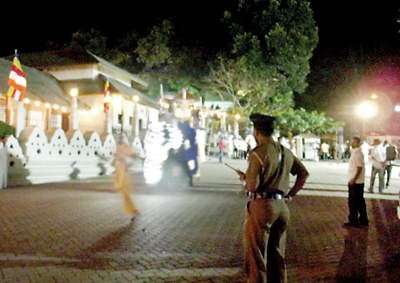Bamboo resumes its ancient glory under major production drive
In another seven years – by 2019 – Sri Lanka would come under 10,000 hectares of bamboo cultivation with 150,000 tons of dry bamboo harvested annually. This would provide, among other major economic benefits, 113 megawatts of electricity to the national grid which would then account for 2.7 per cent of the total electricity generated in the country.

Seen here the Minister exchanges greetings with some donor agency officials. Pic by Mangala Weerasekera.
The project ‘Bamboo Processing for Sri Lanka’ initiated by the United Nations Industrial Development Organization (UNIDO), its Sri Lanka Chapter, and the National Operational Focal Point for Global Environmental Facility (GEF), Ministry of Environment was launched this week in Colombo and set to cost US$24 million. It has taken two years to study the viability of the project in Sri Lanka and to lay the groundwork in place.
Dr Kentaro Aoki, Associate Expert, UNIDO speaking of the divergent economic benefits of the project said that once the entire 10,000 hectares are matured, the harvest connected to various industries envisage a huge income generation for the country and the creation of at least 80,000 jobs. It is aimed to reduce poverty levels in rural areas. He said the bamboo project would create new business opportunities, increase the use of non-imported local products; avoid deforestation; reduce greenhouse gas emissions through bamboo plantation and products; reduce degraded lands and prevent soil erosion. The propagation of bamboo cultivation would increasingly add to the reforestation. It would also fill in old abandoned tea plantations. He said that bamboo comes under the species of grass and it brings in several environmental benefits and production of high quality crafts, furniture and other implements could be produced out of bamboo, and there is a great export potential. It would achieve a dual purpose of high economic as well as enormous environmental benefits.
He said that this highly economic resource is not put to optimum use in Sri Lanka, though there are 14 different bamboo species grown here. Elsewhere in the world the bamboo industry is thriving, highly developed and modern technology is used. In the process of project implementation, technology transfer would also take place, he said adding that bamboo also provides highly nutritious food which is extensively used in countries like Japan and China. A bicycle manufactured with a bamboo frame is being sold at $2,000 and even houses could be built with bamboo. B.M.U.D. Basnayake, Secretary Ministry of Environment said that GEF since 1994 has approved $86.26 million for implementing eight regional and global projects for Sri Lanka. It has so far granted $61.30 million to implement 21 national projects and some of the areas cover bio-mass energy, control of invasive species and development of crop wild relatives. He said Sri Lanka has a land area of 6.5 million hectares and forest cover in the country has dwindled rapidly. In 1881 the forest cover was 84 per cent which by 1956 dropped to 44 per cent. In 1983 it was 27 per cent and the predictions, according to Basnayake, is that in 2020 it would further drop to 17 per cent.
Rishad Bathiudeen, Minister of Industry and Commerce, Nawaz Rajabdeen, National Director, UNIDO were among the other speakers at this launch. Industrialists say that while bamboo growth in Sri Lanka has been known since ancient times, the authorities have failed to identify its high potential, until this UNIDO project came along. In a different focus earlier it was considered a dwindling plant species and restrictions were imposed on bamboo transport without a licence. In the light of this massive project where bamboo is planted and would be cut down on a massive scale for commercial use, the present impediment in transport would be unfair to traditional bamboo craftsmen and further affect their struggle for survival, industrialists said.
Recently the Business Times wrote on the case of an abjectly poor traditional bamboo basket weaver from the outskirts of Bandarawela. He carries on his back a load of bamboo trees cut into pieces, walking at least four miles along secluded routes in a day-long exercise. This is out of fear of breaking the law. Otherwise he could have transported it by road in a 3-wheeler or cart or by other mode of transport which would take only about 15 to 30 minutes, and with no hassle of undue exertion of energy shuttling to and from about 40 miles – if he had a licence.
Due to these transport issues vis-a-vis the licence, many micro scale bamboo craftsmen have abandoned their traditional method of earning a living.
Follow @timesonlinelk
comments powered by Disqus

























